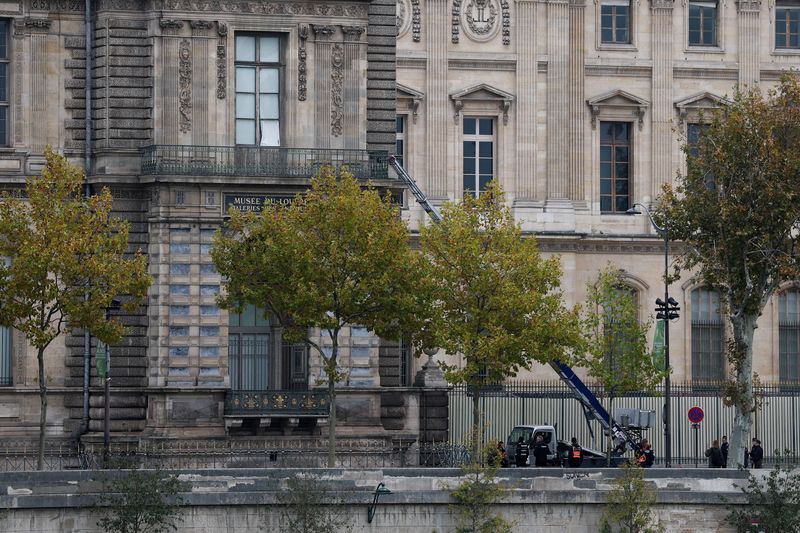By Sybille de La Hamaide
PARIS (Reuters) -Thieves broke into Paris’ Louvre museum on Sunday, using a crane and smashing an upstairs window and stealing priceless jewellery from an area that houses the French crown jewels before escaping on motorbikes, the French government said.
The robbery is likely to raise awkward questions about security at the museum, where officials had already sounded the alarm about lack of investment at a world-famous site, home to artworks such as the Mona Lisa, that welcomed 8.7 million visitors in 2024.
The thieves struck at about 9.30 a.m. (0730 GMT) when the museum had already opened its doors to the public, and entered the Galerie d’Apollon building, the Interior Ministry said in a statement.
ROBBERY WAS ‘VERY PROFESSIONAL’ WITH NO VIOLENCE
The robbery took around four minutes, Culture Minister Rachida Dati told TF1, and was carried out by professionals.
“We saw some footage: they don’t target people, they enter calmly in four minutes, smash display cases, take their loot, and leave. No violence, very professional,” Dati said on TF1.
She said one piece of jewellery had been recovered outside the museum, apparently dropped as the thieves made their escape.
Dati declined to say what the item was, but newspaper Le Parisien said it was believed to be the crown of Napoleon III’s wife, Empress Eugénie. The item was broken, the newspaper said.
“It’s worth several tens of millions of euros – just this crown. And it’s not, in my opinion, the most important item,” Drouot auction house President Alexandre Giquello told Reuters.
“Ideally, the perpetrators would realise the gravity of their crime and the dimension they’ve entered into, and return the items, since the jewels are completely unsellable,” Giquello said.
“We’re touching on the history of France … It’s a completely incomprehensible act, because the perpetrators will have every police force in the world on their tail, and in my opinion, they’ve put themselves in a very precarious situation,” he added.
PROBE UNDERWAY BY SPECIALIST UNIT
Interior Minister Laurent Nunez told France Inter that three or four thieves got into the museum from outside using a crane positioned on a truck.
“They broke a window, headed to several display cases and stole jewels … which have a real historical, priceless value,” Nunez said, adding that the team had likely scouted the location and may have carried out similar thefts in the past.
A video posted on X by a museum guide showed visitors filing towards exits in the middle of their tour, initially unaware of the reason for the disruption.
No injuries were reported, Dati said.
Nunez said a probe had been opened, with a specialized police unit that has a high success rate in cracking high-profile robberies such as this one tasked with running it.
QUESTIONS ON SECURITY
The Louvre, the world’s most-visited museum, said on X it would remain closed for the day for “exceptional reasons”.
Joan and Jim Carpenter, from Santa Cruz, California, said they had been moved out of a gallery just as they were about to see the Mona Lisa.
“Well, when you rob the Louvre, that’s a big deal to all of France, so I knew something was up because of the way they swept the whole museum,” Joan Carpenter said.
The Mona Lisa was stolen from the museum in 1911 in one of the most daring art thefts in history, in a heist involving a former employee. He was eventually caught and the painting was returned to the museum two years later.
Earlier this year, officials at the Louvre requested urgent help from the French government to restore and renovate the museum’s ageing exhibition halls and better protect its countless works of art.
Dati said the issue of museum security was not new.
“For 40 years, there was little focus on securing these major museums, and two years ago, the president of the Louvre requested a security audit from the police prefect. Why? Because museums must adapt to new forms of crime,” she said. “Today, it’s organised crime – professionals.”
(Reporting by Sybille de La Hamaide; Additional reporting by John Cotton, Helen Popper, Clothaire Achi and Ardee Napolitano; Editing by Gabriel Stargardter and David Holmes)

